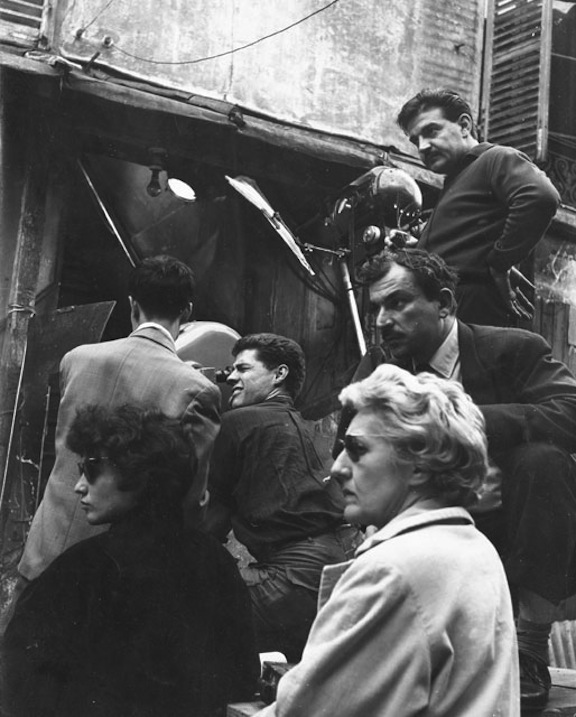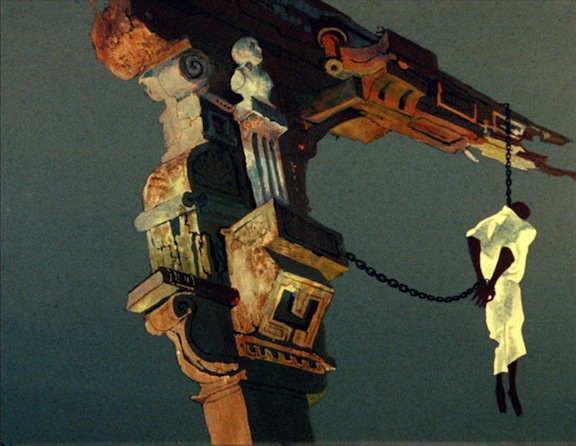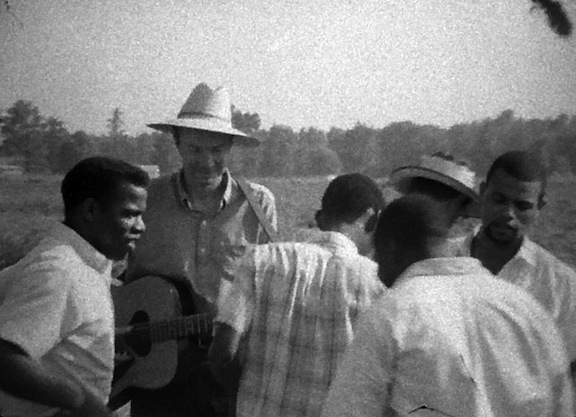39 Institutions Receive Preservation Grants
In its 2016 round of preservation grants, the National Film Preservation Foundation has today [18 May 2016] awarded grants to 39 institutions to ensure the survival of 64 films.
Films covered in the grants include The Streets of Greenwood (1963), a documentary about civil rights activists registering African American voters in Mississippi, and James Blue’s The Olive Trees of Justice (1962), which won a prize at the Cannes Film Festival.
Shot in Algeria during the war for independence with nonprofessional actors, The Olive Trees of Justice (below) depicts the torn loyalty of a Frenchman born and raised in Algeria. That the film was made, at all, is testimony to the persistence of its makers: the studio where it was made was bombed five times by the French dissident far-right paramilitary organization OAS, which opposed the film’s pro-independence stance.

James Blue (center) on the set of his “The Olive Trees of Justice” (1962), a dramatic feature about an Algerian-born Frenchman’s conflicted loyalties during the Algerian War for independence. Credit: James Blue Alliance, which is preserving the film.
The NFPF preservation grants target newsreels, silent-era films, culturally important home movies, avant-garde films, and endangered independent productions that aren’t targeted for preservation by for-profit companies. The awards provide support to create a film preservation master and two access copies of each work. Films saved are then made publicly available for on-site research as well as for screenings and exhibits, DVD manufacture, and television and Internet broadcasting.
The nonprofit NFPF, located in San Francisco, is an affiliate of the National Film Preservation Board of the Library of Congress that the U.S. Congress created in 1996 to help save America’s film heritage. It receives federal money through the U.S. Library of Congress to distribute as grants but raises operating and project funding from other sources. Since its creation by Congress in 1996, the NFPF has provided preservation support to 284 institutions and saved almost 2,300 films through grants and collaborative projects in all 50 U.S. states, the District of Columbia, and Puerto Rico. A catalog of the films is online.
The NFPF publishes the award-winning Treasures from American Film Archives DVD series, which makes available rare films preserved by public and nonprofit archives that have not been commercially distributed
The films to be preserved from this years grants, organized alphabetically by the institutions and organizations leading the preservation projects, are:
Alaska Moving Image Preservation Association: Edna and Howard Cameron Collection (ca. 1938–59), amateur footage by teachers in remote areas of Alaska, depicting their Native students and traditional subsistence activities.
American Jewish Joint Distribution Committee: Rothschild Hospital, Vienna (ca.1945–48), footage of a refuge center for Polish and Romanian Jews displaced by postwar Antisemitism.
Amistad Research Center, Tulane University: Ruby Bridges at School (ca.1961), teacher’s footage of the six-year-old girl who singlehandedly integrated a New Orleans Elementary School, commemorated in Norman Rockwell’s painting The Problem We All Live With.
American Museum of Natural History: Carl and Mary in Africa (1926), documentation of prominent taxidermist Carl Ethan Akeley and his wife Mary Jobe participating in the Eastman-Pomeroy-Ackeley expedition of 1926; also, The Vernay Deer Group (1923–27), documentation of taxidermy techniques and specimen collecting during the Faunthorpe-Vernay Indian Expedition.
The Animation Show of Shows: Hangman (1964), Les Goldman and Paul Julian’s cautionary animated adaptation of Maurice Ogden’s poem about a town that allows its citizens be executed one by one (below).

“Hangman,” Les Goldman and Paul Julian’s 1964 cautionary animated adaptation of Maurice Ogden’s poem. Credit: The Animation Show of Shows, which is preserving the film.
Anthology Film Archives: Seven Films by Vito Acconci (1970–72), super8 shorts by the influential performance artist and architect.
Appalshop: Father Richard J. Reimondo Collection (1951–54), amateur footage shot by a Catholic priest documenting church communities in Hazard, Kentucky.
Buffalo Bill Center of the West: Max Wilde Hunting Films (1940s–50s), documentation of a big game outfitter’s expeditions into the Yellowstone wilderness.
Circus World Museum: Sparks and Christy Bros. Circus Films (ca.1927–28), footage of the smaller, independent circus troupes that thrived before the Great Depression.
Enoch Pratt Free Library: Market (1980), independent documentary about the popular Cross Street Market of South Baltimore; also, Stick Him (1978), profile of renowned boxing trainer Mack Lewis and his East Baltimore gym.
Film-Makers’ Cooperative: Poemfield Nos. 2, 3, & 7 (1967–71), three entries in Ken Knowlton and Stan VanDerBeek’s early computer animation series that translated poems into coded visual messages.
Folkstreams: Watermen (1968), Romas Slezas and Holly Fisher’s documentary portrait of Chesapeake Bay’s oyster-harvesting “skipjacks,” the last operating fleet of sailing workboats in the U.S.
Frelinghuysen Morris House & Studio: George L.K. Harris Travel Films (ca. 1934), home movies of the abstract painter’s Far Eastern travels.
George Eastman Museum: rare 28mm prints of educational and industrial films from 1913–19 — Historic New York Landmarks of American History (1913), A Connecticut Skunk Farm (1914), Making Cut Glass (1914), Kalem Company; Harvesting War Timber (1917), Horse Training by Experts (1918), and Training Man Hunters (1917), Bray Studios, the last on new crime-fighting methods; The Latest Kinks in Canning (ca. 1917) and The Peaceful Dove in War (ca. 1917), from the Paramount-Bray Pictographs series; Manufacture of Paper (1918), International Paper Company; The Mysteries of a Machine Gun (ca. 1918), Pathé Review.
Harvard Film Archive: Birth of a Painting: Kurt Seligmann (1950), documentation of the Swiss-American surrealist painter at work, filmed by Thomas Bouchard, a filmmaker and photographer of dancers and artists; also Fernand Léger in America: His New Realism (1945), Bouchard’s documentary on the Cubist artist’s last stateside visit.
Hoover Institution, Stanford University: ALSOS Mission Films (1943–45), footage documenting the secret task force that investigated Nazi Germany’s atomic bomb program.
Illinois State University: The Art of the Trapeze (ca. 1944–50), amateur footage of aerialists from the Harold Voise and Russell Brothers troupes, with training scenes in the historic Ward-Concello Practice Barn in Bloomington, Illinois.
James Blue Alliance: The Olive Trees of Justice (1962), James Blue’s dramatic feature about an Algerian-born Frenchman’s conflicted loyalties during the Algerian War for independence.
Keene State College: Louis de Rochemont Footage of Portsmouth, New Hampshire (1943), unfinished town portrait shot by the creator of The March of Time newsreel.
Metro Theatre Center Foundation: Augustus Sassa Collection (ca. 1959–68), footage shot by a home movie-maker of John F. Kennedy and Robert Kennedy on campaign.
Milan ’54 Hoosiers Museum: Muncie vs. Milan Championship Game (1954), Milan High School’s Indiana State basketball championship victory, which inspired the 1986 film Hoosiers.
Minnesota Military Museum: WPA Construction at Camp Ripley (ca. 1935), documentation of Works Progress Administration builders assembling the camp’s National Guard training facility.
Montana Historical Society: Senator Lee Metcalf Collection (1965–66), “Washington Reports” filmed by the Senator to inform his Montana constituents of his positions on conservation issues and water management.
Mote Marine Laboratory: Lab Films of Dr. Eugenie Clark (1956–57), research footage from the pioneering ichthyologist who founded the Mote Marine Laboratory.
Nashville Public Library: Nashville Tornado (1933), nitrate footage of the aftermath of the series of tornadoes that ravaged Nashville in 1933.
New York Public Library: Bad Dog (1973), Eliot Noyes and Claudia Weill’s dog’s-eye view of New York apartment life. Viewers never see the dog; rather, they see how it looks for the dog to see a greeting master and fetching his shoes, romping in the park, and failing to impress his owner’s girlfriend; also Peanut Butter and Jelly (1976), Noyes’s animated depiction of a man eating a bread loaf’s worth of sandwiches; also, Noyes’s Sandman (1973), sand animation of dreams.
North Carolina State Archives: South Pacific Air Force Films (ca. 1942–44), amateur footage of the daily life of WWII Air Force personnel stationed on various islands.
Northwest Chicago Film Society: Dan Potter (1969), film critic Fred Camper’s experimental study of an acquaintance in relation to the natural world.
University of Alaska, Fairbanks: Alaska ’35 (1935), footage by glaciologist William Osgood Field, documenting fjord research and farmers in the New Deal settlement program at Alaska’s Matanuska Valley.
UCLA Film & Television Archive: The Murder of Fred Hampton (1971), Howard Alk and Mike Gray’s documentary on the violent death of the leader of the Illinois Black Panther Party.
University of Cincinnati: Dr. Mont Rogers Reid Surgical Films (ca. 1935), footage of operations performed by the author of The Mont Reid Surgical Handbook.
University of Oregon: Luther Cressman Field Work Films (1938–54), documentation of the influential archaeologist’s excavations into Oregon’s ancient human history.
University of Southern California: In the Red (ca. 1979), portrait of the late 1970s San Francisco punk scene; also, Robert M. Weir Collection (early 1930s–40s), color amateur film of family travels through pre-war Nazi Germany.
University of Washington: Joseph F. Rock Collection (1928–32), the earliest moving image documentation of the Naxi ethnic group, filmed in the Chinese foothills of the Himalayas. (The history of the collection is told here.)

“The Streets of Greenwood,” a film about voter registration drive in the American South, and featuring performances Pete Seeger (center) and Theodore Bickel, is being preserved by Washington University in St. Louis. Credit: Washington University in St. Louis
Washington University in St. Louis: The Streets of Greenwood (1963), civil rights documentary about African American voter registration in Greenwood, Mississippi, with performances by Pete Seeger and Theodore Bikel.
Wisconsin Center for Film & Theater Research: The Inheritance (1964), sponsored film celebrating the 50th anniversary of the Amalgated Clothing Workers of America union, narrated by Robert Ryan.
Yale University: 42nd St Movie (1969), Nicholas Doob’s impressionist documentary of New York street life; also Costumed Dancer (1969), Doob’s stylized portrait of a dancer; and, Plastic Saints (1968), Doob’s experimental film featuring footage of the 1967 March on the Pentagon.
Previous Post: A Vengeful, but Oddly Unsorrowful Belladonna
Next Post: Yale to Preserve Documentarian Nick Doob





